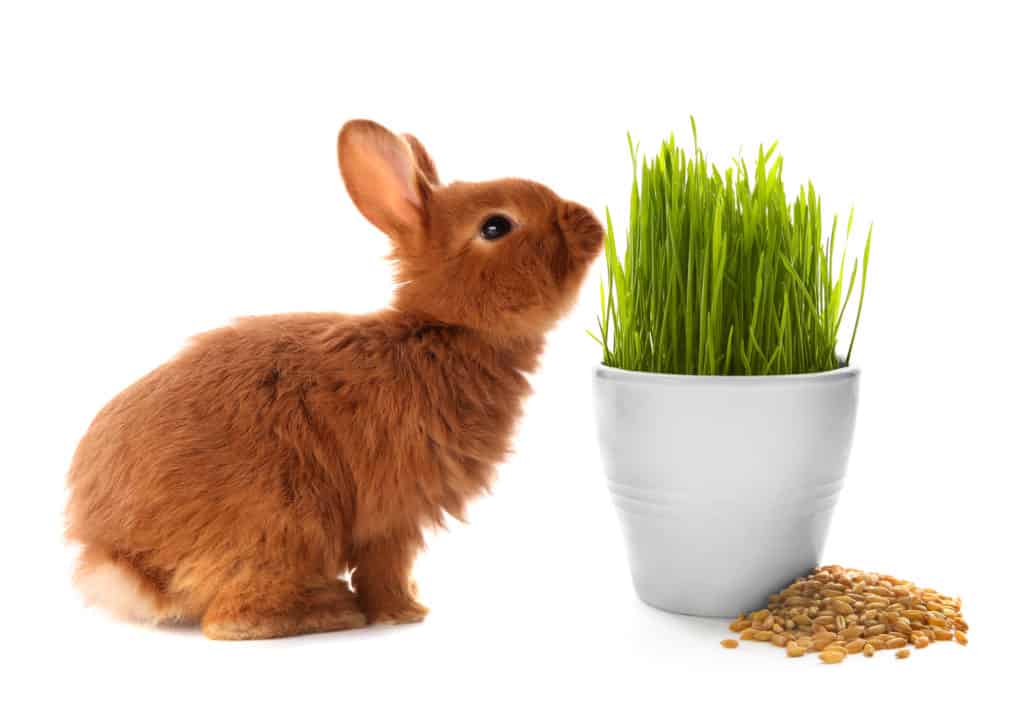Wheatgrass has been used for its nutritional benefits for humans for a long time. But can it also be good for pets, and is it safe for them to eat?
Read on to find out if rabbits can eat wheatgrass safely!
Can Rabbits Eat Wheatgrass?
Yes, rabbits can eat wheatgrass and can benefit a lot from consuming moderate amounts with their other vegetables.
Nutritional Information Of Wheatgrass
There are no officially confirmed sources that list the exact, specific nutritional information of raw wheatgrass.
This is likely because wheatgrass is only used in juice and powder forms by human beings, so the need to document raw wheatgrass’ nutritional content isn’t present.
With that being said, there are some bits of information we do know about the nutritional value of raw wheatgrass.
To begin with, it boasts a notable protein amount, providing a minimum of 17 types of amino acids within that protein. It is also a good source of dietary fiber, though that fiber content is low compared to the hay that rabbits eat.
Wheatgrass is also known to have a good amount of:
- Vitamin A
- Vitamin B6
- Vitamin C
- Vitamin E
- Vitamin K
- Potassium
- Thiamin
- Niacin
- Riboflavin
- Zinc
- Iron
- Copper
- Selenium
- Manganese
- Pantothenic acid
You can look up information on wheatgrass powder or juice to get a better idea of the way these nutrients are distributed, but that information won’t be an entirely accurate way to gauge the nutrition of wheatgrass for your rabbits.
Potential Hazards To Watch For When Feeding Wheatgrass
Most hazards that may pop up when feeding wheatgrass to rabbits have to do with overfeeding. Too much of anything can be dangerous for any pet.
The primary issue is a lack of fiber. Excessive feeding of wheatgrass will leave too little space in your rabbit’s stomach for hay.
This means that rabbits cannot get fiber from hay, and wheatgrass is very low in fiber and won’t supplement the loss. This can cause problems like GI stasis, uneaten or soft cecotropes, or even intestinal blockage.
Another potential hazard from excessive wheatgrass consumption in rabbits is diarrhea, caused by large amounts of wheatgrass and its components upsetting your rabbit’s stomach.
If you notice this problem in your rabbit even when feeding very little wheatgrass, you should stop giving it this food.
3 Benefits To Feeding Your Rabbit Wheatgrass
1. It Has High Nutritional Content
Wheatgrass is considered a superfood in the world of human food because of its high nutritional content.
Protein, vitamins, and minerals are present in abundance, and your rabbits will be able to get all of them from a quick snack!
2. It Lowers Blood Sugar
Animal studies have shown that wheatgrass can help to balance the blood sugar level in animals with diabetes. If you’re hoping to help your rabbits manage their glucose levels, this is a great choice.
3. It Lowers Cholesterol
A study conducted on rabbits who ate high-fat diets showed that wheatgrass was able to reduce overall cholesterol levels and boost good cholesterol after just 10 weeks.
This is a great sign that wheatgrass can help to keep your rabbits healthy, boost their heart health, and help with weight management.
Best Ways To Feed Wheatgrass
The best way to feed wheatgrass to your rabbits is raw by allowing them to nibble on wheatgrass in a pot.
This is why many rabbit owners choose to grow their own wheatgrass at home! They can simply bring the pot down to their rabbits to snack on, then remove it once they’ve had enough.
You can also cut off strands of wheatgrass and mix them in with other vegetables for your rabbits to munch.
You should never give your rabbits wheatgrass powder or juice. Stick to raw wheatgrass only!
How Much Wheatgrass Can A Rabbit Safely Have
Rabbits can safely have as much wheatgrass as their daily vegetable requirements allow. This means that rabbits can have:
- A maximum of 128 grams of wheatgrass per day if they’re a small breed of 3.5 pounds or lower
- Anywhere from 384 to 640 grams of wheatgrass per day if they’re a medium breed of between six and 10 pounds
- Anywhere from 384 to 760 grams of wheatgrass per day if they’re a large breed of between nine and 12 pounds
It’s a good idea to speak to your vet about your rabbit’s specific vegetable requirements.
Keep in mind that veggies should only make up about 10% of a rabbit’s diet!
Other Tips For Feeding Wheatgrass To Your Bunny
Do note that just because a rabbit can safely have a lot of wheatgrass within its vegetable limit, that doesn’t mean that it should have that much!
A rabbit needs a diet of varying vegetables, not just wheatgrass, to flourish, receive necessary nutrients, and experience good gut health.
In general, you shouldn’t give your rabbit wheatgrass every day.
Instead, it should be a small part of a variety of different vegetables that you give to your rabbit as part of its daily vegetable needs.
Rotate it in and out with other favorites to meet nutritional requirements and prevent tummy problems!
Age is also an important factor to consider. Rabbits younger than 12 weeks of age should not be eating any vegetables at all, and juvenile rabbits below the age of a year shouldn’t be eating too many veggies.
Finally, when you first give your rabbit wheatgrass, provide only 15 grams of the stuff first. Monitor your rabbit for any adverse reactions and stop if you notice any.
If your rabbit takes well to the food, then you can slowly increase the total wheatgrass you provide over time until you hit the desired amount.
Conclusion
Many rabbits enjoy chewing on wheatgrass and eating it alongside other vegetables. As long as you provide this food to them in moderation, they’ll enjoy plenty of benefits from all the nutrients contained in this vegetable!

